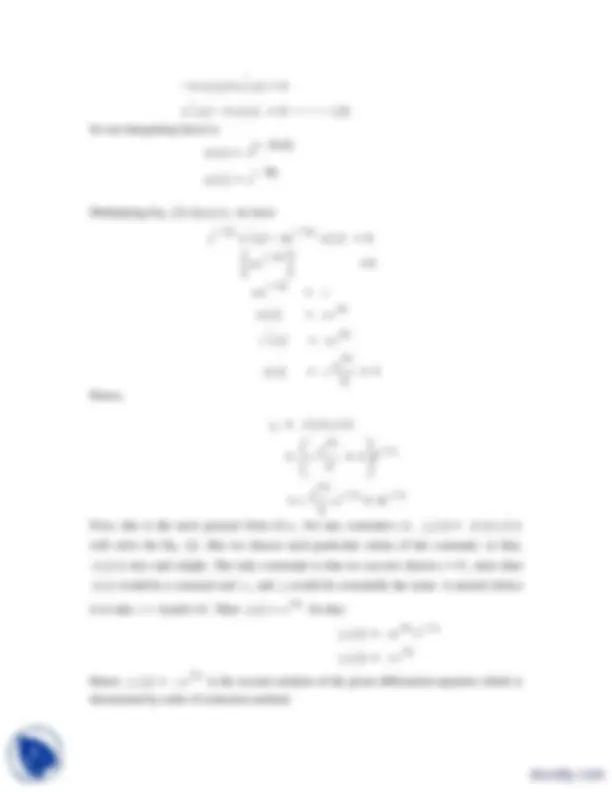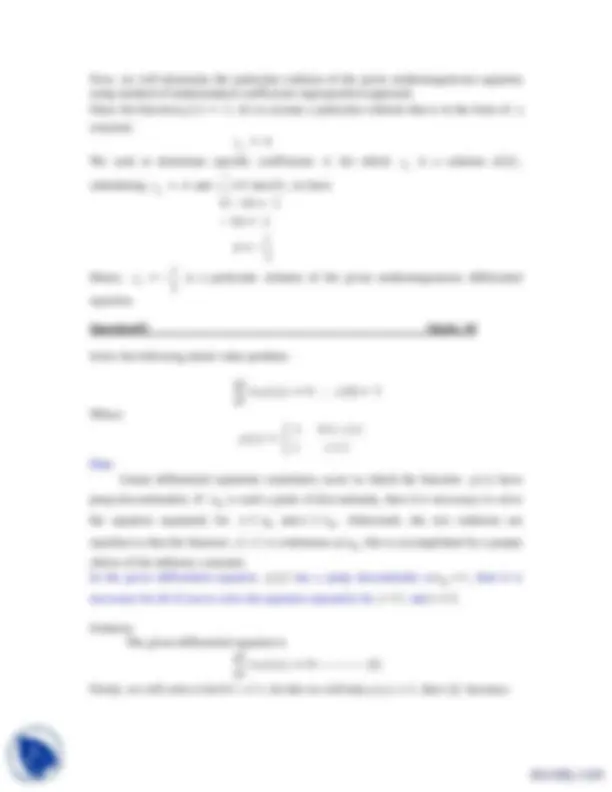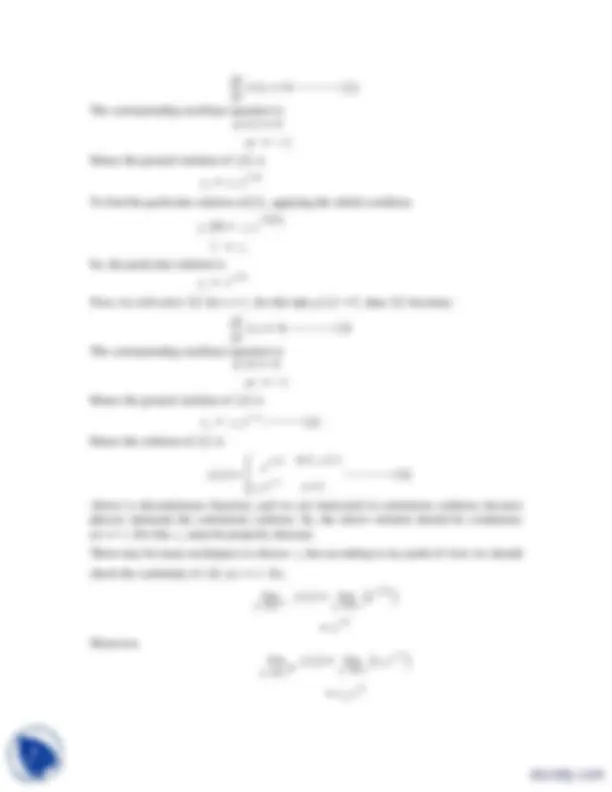





Study with the several resources on Docsity

Earn points by helping other students or get them with a premium plan


Prepare for your exams
Study with the several resources on Docsity

Earn points to download
Earn points by helping other students or get them with a premium plan
Community
Ask the community for help and clear up your study doubts
Discover the best universities in your country according to Docsity users
Free resources
Download our free guides on studying techniques, anxiety management strategies, and thesis advice from Docsity tutors
The solution to assignment #2 in mth401 (spring 2012) for a second-order linear differential equation. The solution involves finding the second solution of the homogeneous equation using the method of reduction of order and a particular solution of the nonhomogeneous equation using the method of undetermined coefficients-superposition approach.
Typology: Exercises
1 / 6

This page cannot be seen from the preview
Don't miss anything!




MTH401 (Spring 2012)
Total marks: 30 Lecture # 12- Due date: 06-06-
DON’T MISS THESE Important instructions: Upload assignments properly through LMS only, (No Assignment will be accepted through email). All students are directed to use the font and style of text as is used in this document. In order to attempt this assignment you should have full command on Lecture # 12 to Lecture # 18.
This is an individual assignment, not group assignment, so keep in mind that you are supposed to submit your own, self made & different assignment even if you discuss the questions with your class fellows. All similar assignments (even with some meaningless modifications) will be awarded zero marks and no excuse will be accepted. This is your responsibility to keep your assignment safe from others. Above all instructions are for all assignments so may not be mentioned in future. Solve the assignment on MS word document and upload your word (.doc) files only. Do not solve the assignment on MS excel. If we get any assignment on MS excel or any format other than word file then it will not be graded. Assignments through e-mail are not acceptable after due date (If there is any problem in submitting your assignment through LMS, you can send your solution file through email with in due date). You are advised to upload your assignment at least two days before Due date.
Question#1 Marks 10
In the following differential equation the indicated function y 1 x is a solution of the
associated homogeneous equation. Use the method of reduction of order to find a second solution y 2 (^) x (^) of the homogeneous equation and a particular solution of the given
nonhomogeneous equation using method of undetermined coefficients-superposition approach.
1
2 2 2 4 2 ;^1
d y (^) y y e x dx
Solution: Let y 2 (^) v x (^) y 1 (^) x is the second solution of the given differential equation. That is we have to determine v x (^) .
Now y 2 and its derivatives are
2
2
2 2 2 2 2 2 2 2 2 2 2 2 2 2 2 2 2 2 2 2 2 2
x
x x
x x x x
x x x x
x x x x
x x x
y v x e
y v x e e v
y v x e e v e v v e
y v x e e v e v v e
y e v x e v e v e v
y e v x e v e v
Now plugging the above values into associated homogeneous Eq. (^) (^1) so one can solve
for v x (^) ;
2 2 2 2
2 2
x x x x
x x
e v x e v e v v x e
e v e v
v v
This is second order linear differential equation, so, substitute w x (^) v ' (^) x into Eq.
2 , it yields
Now, we will determine the particular solution of the given nonhomogeneous equation using method of undetermined coefficients-superposition approach.
Since the function g x 2 , let us assume a particular solution that is in the form of a
constant:
We seek to determine specific coefficients A for which y (^) p is a solution of (^) 1 ,
substituting y (^) p A and y '' (^) p 0 into (^) 1 , we have
0 4 2 4 2 1 2
Hence,
equation.
Question#2 Marks 10
Solve the following initial value problem.
0 ;^ 0 ^1
dy p x y y dx
Where
x p x x
Hint: Linear differential equations sometimes occur in which the function p (^) x (^) have
matched so that the function y x is continuous at x (^) 0 ; this is accomplished by a proper
choice of the arbitrary constants. In the given differential equation p (^) x has a jump discontinuity at x 0 (^) 1 , then it is
Solution: The given differential equation is
0 ^1
dy p x y dx
Firstly, we will solve it for 0 x 1 , for this we will take p x (^) 2 , then (^) 1 becomes:
(^2 0) 2
dy y dx
The corresponding auxiliary equation is: 2 0 2
m m
Hence the general solution of (^) 2 is
1 1
To find the particular solution of (^) 2 , applying the initial condition
1 1 1
20 0 1
y c e c
So, the particular solution is
1
Now, we will solve 1 for x 1 , for this take p x 1 , then 1 becomes:
0 3
dy y dx
The corresponding auxiliary equation is: 1 0 1
m m
Hence the general solution of (^) 3 is
y (^) 2 c e 2 ^^ x a
Hence the solution of (^) 1 is
2
x x
x e y x c e x
Above is discontinuous function, and we are interested in continuous solution, because physics demands the continuous solution. So, the above solution should be continuous
There may be many techniques to choose c (^) 2 but according to my point of view we should
check the continuity of (^) 4 at x 1. So,
(^) 2
2
lim lim 1 1
y x e^ x x x
e
Moreover,
(^) 2
2
1
lim lim 1 1
y x c e^ x x x c e